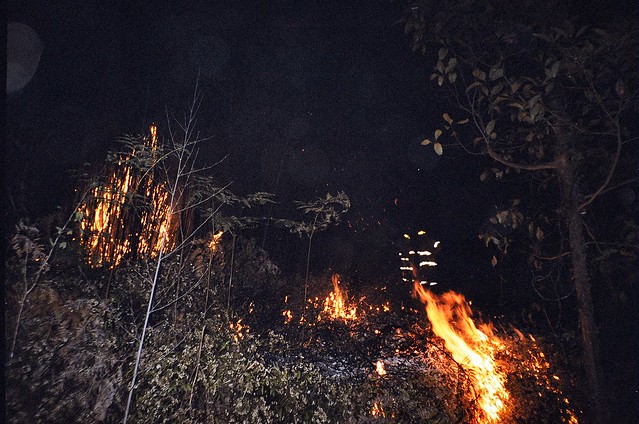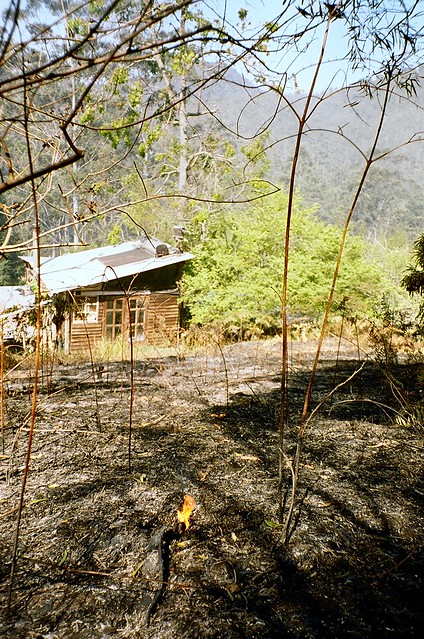Fire and Storms
The air is filled with smoke again, coming over the mountain to settle in the valley. Wildfires are usually (thankfully) rare this time of year, but it seems the times they are a’changing.
Helicopters circle in the pea-soup smoke and the river beckons in the sweltering heat. Like most fires, this was lit by human hands. Wonder Boy enjoys his holiday as eye keep him out of the smoke. Storms thunder past day by day, neither lighting the fires nor putting them out – yet.
Eye am loathe to call the fire brigade after decades of experience; a quarter of them are literally pyromaniacs, a quarter have never been to a fire before, a quarter just want to get back to defend their own homes and act swiftly and incautiously, fighting fire with fire. And a quarter are honest and capable and always very apologetic. They’re great to have around when the wall of flames bears down on your house – only problem is, they usually started it themselves.

The only fires for a century in this valley have been lit by ‘firemen’. It’s just like Fahrenheit 451 by Ray Bradbury, where the firemen destroy all knowledge of the past by burning books. Eye suppose books have leaves as well. Many of them were and are also meat makers – cattle ranchers who see the forest as an impediment to more money, more grass – and as a threat, dangerous and relatively unknown by these ex-European newcomers.
Here in Oz the Munchkin legend has arisen that you can only fight fire with fire by ‘backburning’, and the bush will recover and prosper – the Aborigines did it, after all – but their practices were radically different from ours. On this continent that was only ever true of the dry interior, grassy beach fringes and the variable tropics, and not at all best or usual practice on the coastal fringes and foothills where most of the population now dwells – which were mostly rainforest.
Fire destroys rainforest and encourages pyrophytic – fire-loving – species such as the vast majority of gum (eucalyptus) trees. These trees, in turn, love fire and create great conditions for MORE fire. Most fire-loving trees evolved in the high and dry country; the valleys that were cleared for settlement and agriculture were almost all millennial rainforests (except where the soil was too nutrient-poor or dry). The hills and mountains, dry and regularly struck by lightning, were the home of the gum trees – with a few notable exceptions that could thrive on the edges of and within the wetter, multi-canopied shade forests of the valleys and gullies. The primeval mosaic of dry and wet forests meant that wildfires rarely travelled far before being damped down.
Rainforest trees and plants will rarely burn – unless infiltrated by more combustible types. Their canopy promotes the retention of water, holding off evaporation and encouraging springs to rise to the surface. Encouraging rainforest and discouraging fire-loving species is what’s required to save humans and their ecosystem here.
In practice it’s all a little more complex; some species of drier-type trees are required by all sorts of endangered animals and birds. Many mature eucalypts won’t burn, but almost all inhibit the growth of non-eucalypts and provide a ready and plentiful source of combustible wood. By comparison, it’s very hard to actually get most rainforest wood to burn.
There are still many species of eucalypt trees which could be profitably harvested, selectively, where the rainforest is already regenerating. This would help protect these areas – if the logging doesn’t smash open the canopy and expose the soil to the sun and wind. An increase in wind-speed can be expected in these transitional times, drying the planet and damaging the shade-giving forests further.
Regular burning and most agricultural practices have the effect of drying and destroying the soil, thinning forests and destroying the rivers. The carbon, of course, is taken from the ecosystem and regularly thrust into the atmosphere, already brimming over with CO2. Instead of growing deeper, soils themselves are burned away, becoming thinner and more fragile, easily washed into the rivers to silt them up in heavy rains.
Relining the riverbanks with trees is a primary priority for most of us in the bush – as is relacing pasture with trees, fire-loving trees with water-loving ones, old attitudes with new awareness and old habits with subtly radical actions.
Turning from the notion of ‘fighting fire with fire’ is also required and remineralising our demineralised soils would also make a massive difference – simply dispersing finely crushed rock and gravels would help plants and shellfish absorb far more carbon more easily.
It takes a transformation of habits and traditions into a new, conscious culture.

Aquarius is the water-bearer, after all…
- R. Ayana
images - http://farm3.static.flickr.com/2040/1582800969_3906dd57c8_b.jpg
http://farm3.static.flickr.com/2187/2010463702_f844fccb3d_b.jpg
For further enlightenment see –
The Her(m)etic Hermit - http://hermetic.blog.com
This material is published under Creative Commons Copyright – reproduction for non-profit use is permitted & encouraged, if you give attribution to the work & author - and please include a (preferably active) link to the original along with this notice. Feel free to make non-commercial hard (printed) or software copies or mirror sites - you never know how long something will stay glued to the web – but remember attribution! If you like what you see, please send a tiny donation or leave a comment – and thanks for reading this far…
From the New Illuminati – http://nexusilluminati.blogspot.com


No comments:
Post a Comment
Add your perspective to the conscious collective